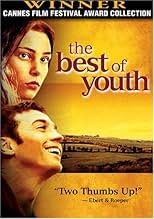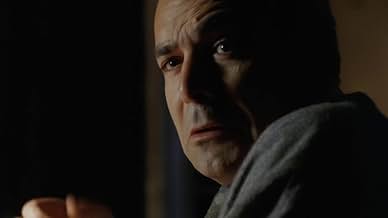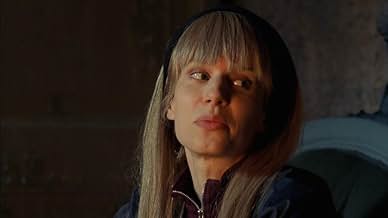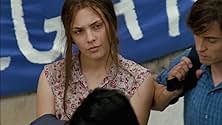Uno sguardo alle vite dei borghesi Carati, padre romano e madre milanese, con due figli maschi e due femmine, dall'estate 1966 ai giorni nostri, attraverso i grandi eventi collettivi di queg... Leggi tuttoUno sguardo alle vite dei borghesi Carati, padre romano e madre milanese, con due figli maschi e due femmine, dall'estate 1966 ai giorni nostri, attraverso i grandi eventi collettivi di quegli anni.Uno sguardo alle vite dei borghesi Carati, padre romano e madre milanese, con due figli maschi e due femmine, dall'estate 1966 ai giorni nostri, attraverso i grandi eventi collettivi di quegli anni.
- Regia
- Sceneggiatura
- Star
- Premi
- 33 vittorie e 25 candidature totali
Recensioni in evidenza
"The Best of Youth" focuses on various members of the Carati family and their friends, advancing from the 1960s to the near-present as it chronicles their lives in the context of social turmoil in Italy as a whole. For the most part, the story never drags, and every single character is compelling and sympathetic.
Many of the character have flaws, but they're not bad people - just complex. Many tragic things happen, but the film never wallows in misery, except on one wholly justified occasion. Moral conflicts are explored not in black-and-white, but in shades of grey. In other words, "The Best of Youth" is rich with the kind of warmth, complexity and subtle nuances that you tend to miss in most American dramas - even the ones that win Oscars.
I won't spoil the plot, really - I'll just say that both of the main characters, brothers Matteo and Nicola Carati, are charismatic and cool and well worth six hours of screen time. They're also very different, which keeps things interesting.
Are there any significant flaws here? Nah, not really. My interest waned a bit during some segments, particularly the historical ones that aren't explained that well. There's also a bit of cheesy makeup and blue screen, but that can be excused because this is really a TV production, as I understand it, not a big movie. Besides, I sort of love production flaws. They're fun, aren't they?
On a totally pointless note, I'd like to mention a strange plus of "The Best of Youth" - much of the cast is totally gorgeous. Guys and gals alike have reason to rejoice here...
One final random thought. While I'm glad that "The Best of Youth" was distributed and well-received in the U.S., I'm annoyed that it was publicized as being "like the Godfather" or "like the works of Scorcese." It's nothing like the Godfather, it's nothing like Scorcese. The marketers seemed to have believed, unfortunately, that U.S. audiences are only interested in Italian criminals, not normal Italian people. This sort of irritates me. (Note my surname and you'll figure out why!) But such concerns have nothing to do with the actual movie, which is pretty much flawless.
What I admired most throughout this film was the use and passage of time. Events in Italian history are not crammed into 120 minutes but is instead elongated, as Matteo and Nicola react in their own ways to the events that occur in their country. Time is such an important factor in this film, evidents not only by the six hour running time, but how those six hours are treated. Special occasions occur, yet none are given any special attention. The events that occur are important for that moment in time, yet one pass become mere memories such is the case of life.
With the passage of time, The Best Of Youth became such a moving experience for me. I felt as if I were a part of their family. I could not touch them, or talk to them, yet they seemed to welcome me with open arms as I silently watched their lives unfold before me. I could feel the love this family had for each other as I laughed and cried right beside them. Words just do not seem to be enough to describe the brilliance of this film. It is literally life transferred on screen.
The Best of Youth is remarkably acted and directed. At no time during this film was I bored, because such attention is made to character development, script, and cinematography. In the first part of the film, Nicola is exploring Norway, and sends a postcard to his brother back home telling him of his travels and experiences, and in three words, seems to sum up the film perfectly: "Life is beautiful." After viewing this film, you will share the same perspective.
HIGHLY Recommended
Covering a somewhat same period of the baby boom generation as "In A Land of Plenty," it has more of the generational feel of individuals caught up in history as we have usually seen in British mini-series about end-of-the-eras or World War I, such as "Brideshead Revisited" and "Jewel in the Crown." U.S. mini-series were more successful as sweeping historical epics, even when they were also family sagas like "Roots" and "Centennial;" when the networks tried to interpret more recent history, as in "The Sixties," the set characters sped through "Zelig" and "Forest Gump"-like in happening to be at the right place at the right time; perhaps the several seasons combined of the NBC series "American Dreams" could be considered comparable in showing how the times that are a-changing affect a family.
"Best of Youth" is being released in the U.S. in movie theaters, though I'm not sure even shown in two parts of three hours each how edited it is from the original format, as other grand European mini-series like "Berlin Alexanderplatz," "Das Boot" and "Fanny and Alexander" were originally only shown in the U.S. in truncated theatrical versions as even PBS seems averse to television with subtitles so we rarely get to see the best of world television. Comparison to the Italian film "The Leopard" is unfair as that was not created in the same format and covers a shorter period of historical time.
"Best of Youth" combines charismatic acting, leisurely directing amidst beautiful scenery in several parts of Italy with writing that takes the trajectories of complex yet consistent characters' lives believably and searingly affected by uniquely Italian experiences of the baby boomers' young adult years through middle age, without the American tendency to reject or regret youthful ambitions, through the lens of local natural disasters, violent political activities, judicial battles against the Cosa Nostra, European economic changes, with regional variations, that Americans rarely see in movies.
The focus is primarily on two brothers from the 1960's almost to the present, played by two actors who must be the equivalent of George Clooney and Richard Chamberlain in Italian television. Alessio Boni in particular as Matteo captures the screen with such tortured macho dynamism that it's no wonder he's gone on to play Heathcliff and Dracula in other mini-series. His Paul Newman-like startling blue eyes become a talking point of the series and a continuing visual leitmotif. Similarly, the physical differences between the two actors help to point up the different paths the brothers take through life, even as the casting of other family members to look like them is eerily effective.
The series is particularly good at capturing the camaraderie amongst old male friends over the years and the intimate interactions of members of a family, particularly with children, with a strong theme of the importance of both as an anchor.
Unlike in American TV where women are adjuncts as the girlfriend/wife/mother, the key women here are crucial fulcrums in the brothers' lives and have separate intellectual, psychological and emotional demands.
The emotions are important here -- grief is shown very movingly, with more pain and tears than American culture usually allows. In one extended scene, we see a grieving mother walk slowly up a long flight of stairs in numbed silence and gradually see her revive as she learns of surprise news about her son.
There are of course some coincidences of family members' and friends' paths crossing at key junctures, but the story overall grips us.
The pop music selections,American, European and Italian, are wonderfully evocative.
Almost never in my over 60 years of film viewing have I been as deeply affected, haunted by characterizations, poetic dialog and brilliantly unexpected turns...and breadth of scope. The nuances of relationship between people...in this case the Italian family Carati, their lovers, friends, wards...are so moving, so deeply portrayed and inhabited by the actors that I was not only moved to tears, but inspired. Here is a view of how human beings can live the humanity so desperately needed in this crazed and warring world...also presented as an integral part of plot and interaction...and this done without any sort of didactic or polemic foisting...All achieved through the intimate and profound struggles of the film's characters.
Imagination and the incredible sensibility of director (Marco Tullio Giordana),writers (Petraglia and Rulli) and actors (most outstanding: Luigi LoCacio, Alessio Boni, Adriana Asti and Jasmine Trinca) combine to offer a film that carried this participant (for that's what I felt) into a realm only experienced by exceptional literature.
As is obvious...I highly recommend seeing this movie.
Rarely does a new film find a place on a longstanding short list of best ever. The Italian import Best of Youth recently entered my all time best ten, a singular honor considering I had to sit still for six hours of viewing, and I rarely sit still anytime, even if my name is DeSando and it's a family saga.
Director Francis Ford Coppola created a movie empire with his Godfather series and ended up with what some consider the best American movie ever made. It is unforgettable for its emphasis on family values mafia style and its stunning photography. The Best of Youth is decidedly not mafia related; rather it is a romantic and historical rendering of Italy from the 1960's as seen through the lives of the Carati family and their friends and lovers. The two brothers, Nicola and Matteo, represent the Janus-like conflict of liberal and conservative in the volatile last half-century of Italian social and cultural change.
This is humanistic history at its best as director Marco Tullio Giordana takes us through the sexy seventies, a devastating Florence flood, the emergence of Red Brigades, assassinations and business downturns including the Fiat layoffs. Despite deaths, suicide, and disappointment, the last line of the film, spoken in the new century, repeats the sentiment of the youthful days in the last century that everything is truly beautiful. How can you miss that theme when the cinematography emphasizes the antique charm of Italy and the close up beauty of actors who look their parts, albeit rarely ugly? The film, often tightly framed, accentuates character over plot and a certain imprisonment in character and destiny. The choice of actors is nothing short of inspired.
The genius of Best of Youth is that like Italy itself, this family is a stew of ideologies that offers up dignity of the individual as the highest value and respect (remember The Godfather) for humanity the only arbiter of peace. This film stands with Brokeback Mountain and The New World as a towering achievement and testimony to the transcending power of art to make us look at ourselves as vulnerable and beautiful.
Lo sapevi?
- QuizOriginally developed as a miniseries for television. It was then released in cinemas in June 2003 as two three-hour films after the uncut six-hour version had been screened to great acclaim at the Cannes Film Festival. It was eventually aired on Italian TV as originally intended, in 4 parts, in November 2003.
- Blooper(at around 27 mins) After a caption has shown that the film is set in 1966 at the beginning and the main characters are getting into a car, a radio is heard playing the song "Might just take your life" by Deep Purple. This song was released in 1974.
- Citazioni
Sara Carati, adult: What should I do?
Nicola Carati: I don't know, it depends on how strong you feel... Are you happy now?
Sara Carati, adult: Of course I am!
Nicola Carati: Then, it's time to be generous
- ConnessioniEdited into Colpiti al cuore (2019)
I più visti
- How long is The Best of Youth?Powered by Alexa
Dettagli
- Data di uscita
- Paese di origine
- Siti ufficiali
- Lingue
- Celebre anche come
- The Best of Youth
- Luoghi delle riprese
- Aziende produttrici
- Vedi altri crediti dell’azienda su IMDbPro
Botteghino
- Lordo Stati Uniti e Canada
- 274.024 USD
- Fine settimana di apertura Stati Uniti e Canada
- 7490 USD
- 6 mar 2005
- Lordo in tutto il mondo
- 2.799.773 USD
- Tempo di esecuzione
- 6h 14min(374 min)
- Colore
- Mix di suoni
- Proporzioni
- 1.85 : 1




















